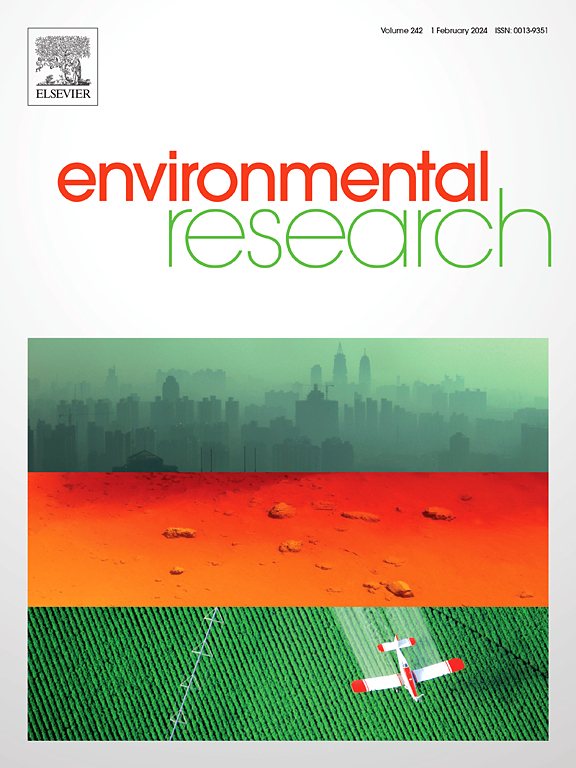PM2.5诱导动脉粥样硬化的新机制:来源依赖性毒性和发病机制。
IF 7.7
2区 环境科学与生态学
Q1 ENVIRONMENTAL SCIENCES
引用次数: 0
摘要
暴露于细颗粒物(PM2.5)可诱发动脉粥样硬化,但其潜在机制尚不完全清楚。本研究使用2017-2020年在中国关中平原重度污染地区之一收集的环境PM2.5样本,并采用ApoE-/-小鼠模型研究PM2.5暴露与动脉粥样硬化之间的关系。尽管由于实施了一系列排放控制措施,环境PM2.5浓度从266.7±63.9 μg - m-3大幅下降到124.4±37.7 μg - m-3,但与对照组相比,PM2.5暴露引起的心血管毒性仍处于显著高水平。此外,研究结果还表明,生物质燃烧对PM2.5的贡献增加,而大多数人为源的贡献减少。本研究发现,PM2.5暴露会导致血管氧化应激和炎症,加速动脉粥样硬化斑块的生长,并改变血管增殖途径。后两种机制为PM2.5如何增强动脉粥样硬化过程,促进血管细胞对脂蛋白胆固醇(LDL-C)的吸收,以及直接刺激与PI3K/AKT信号通路高度相关的细胞功能因子(VEGF和MCP-1)提供了新的见解。多环芳烃(PAHs)及其衍生物和某些生物标志物与生物反应性有很强的相关性,而BB被确定为PM2.5毒性的主要贡献者。这些发现为PM2.5促进动脉粥样硬化的作用提供了新的见解,并为控制PM2.5污染提供了建议,以预防和治疗这种疾病,特别是对易感人群。本文章由计算机程序翻译,如有差异,请以英文原文为准。

New mechanisms of PM2.5 induced atherosclerosis: Source dependent toxicity and pathogenesis
Exposure to fine particulate matter (PM2.5) is recognized to induce atherosclerosis, but the underlying mechanisms are not fully understood. This study used ambient PM2.5 samples collected in one of the highly polluted regions of Guanzhong Plain in China (2017–2020) and an ApoE−/− mouse model to investigate the association between exposure to PM2.5 and atherosclerosis. Despite a substantial decrease in the ambient concentration of PM2.5 from 266.7 ± 63.9 to 124.4 ± 37.7 μg m−3 due to the execution of a series of emission controls, cardiovascular toxicity due to exposure to PM2.5 remained at a significantly high level compared with the Control group. Moreover, the result highlighted that biomass burning (BB) showed an increased contribution to PM2.5 while most anthropogenic sources decreased. This study found that PM2.5 exposure led to vascular oxidative stress and inflammation, accelerated atherosclerotic plaque growth, and altered vascular proliferation pathways. The latter two mechanisms provide new insights into how PM2.5 enhanced the processes of atherosclerosis, promoted lipoprotein cholesterol (LDL-C) absorption in vascular cells, and directed stimulation of cell function factors (VEGF and MCP-1), which are highly associated by PI3K/AKT signaling pathway. Polycyclic aromatic hydrocarbons (PAHs) and their derivatives, and certain biomarkers showed strong correlations with bio-reactivity, while BB was identified as a major contributor to toxicity of PM2.5. The findings offer new insights into the role of PM2.5 promoting atherosclerosis and provide recommendations for controlling PM2.5 pollution to prevent and treat the disease particularly for susceptible populations.
求助全文
通过发布文献求助,成功后即可免费获取论文全文。
去求助
来源期刊

Environmental Research
环境科学-公共卫生、环境卫生与职业卫生
CiteScore
12.60
自引率
8.40%
发文量
2480
审稿时长
4.7 months
期刊介绍:
The Environmental Research journal presents a broad range of interdisciplinary research, focused on addressing worldwide environmental concerns and featuring innovative findings. Our publication strives to explore relevant anthropogenic issues across various environmental sectors, showcasing practical applications in real-life settings.
 求助内容:
求助内容: 应助结果提醒方式:
应助结果提醒方式:


